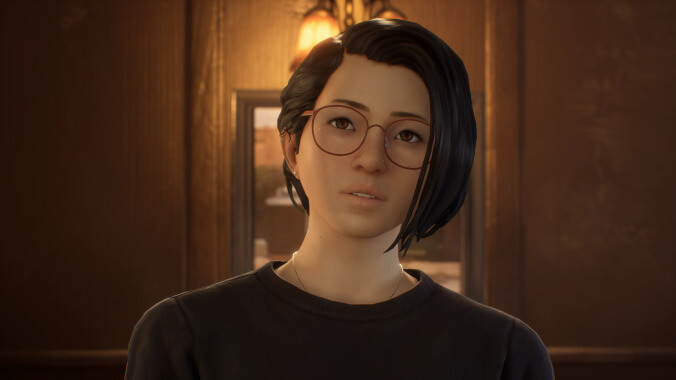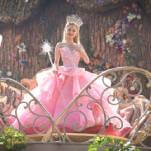Life Is Strange: True Colors Image: Square-Enix
Every Friday, A.V. Club staffers kick off our weekly open thread for the discussion of gaming plans and recent gaming glories, but of course, the real action is down in the comments, where we invite you to answer our eternal question: What Are You Playing This Weekend?
Haven Springs, the small Colorado town that serves as the almost nauseatingly welcoming setting for this week’s
Life Is Strange: True Colors—the fourth title, give-or-take, in the
long-running series of lightly supernatural adventure games—is a fantasy. (And not just in a lengthy, and delightful, sequence that sees the good-natured townsfolk transform themselves into a city-wide LARP setting on behalf of a grieving boy.) With its smiling people, generous bar-owners, well-stocked indie record stores, affordable weed dispensaries, and other signifiers of freedom in a post-teen life, Haven (crafted by developer Deck Nine, who also developed 2017's
Life Is Strange prequel,
Before The Storm) feels drawn more from a longing for a perfect place than an actual location, a Brigadoon set in the sort of independent relationship dramas that this series loves pulling its inspirations from. (Down to including a number of periodic prompts that encourage the player to sit down, look at the gorgeous scenery, and listen to the game’s typically impeccable soundtrack of licensed and original soft-guitar crooning.) It’s enough to set your hackles on rise: Anyone who’s ever seen… well, anything, ever, might suspect this bucolic vision is likely to implode at any moment, especially in light of the shady mining conglomerate that runs large swathes of the town, and an early, plot-propelling death of a major character.
But despite a few harrowing moments, True Colors proves itself largely disinterested in that sort of external horror—for all that the series sometimes feels like a companion to Supermassive’s Until Dawn, a playable Garden State in contrast to that game’s interactive pulls from the VHS bargain bin. No, when True Colors wants to hurt you, it does so by going inside—into the mind, and powers, of protagonist Alex Chen.
Voiced—with equal and able notes of hope, despair, and alienation—by Erika Mori, Alex has a secret: She can see other people’s feelings. And not in a “Oh, she’s just got a high emotional IQ” deal; Alex sees feelings—especially negative feelings—as bright auras of color, raging red, despairing blue, or terrified purple. And feels them too, to the extent that they can infect her and seize control of her body, a condition that has left her with a large and troubled casefile in the foster care system she’s only recently escaped from, traveling from Portland to Colorado to live with her long-lost brother Gabe. But as dangerous and overwhelming as it can be, Alex’s condition also gives her power: To understand people, to read their minds—and even, in extreme circumstances, to change them. That’s the central hook of True Colors, which asks you to decide how often, and where, Alex chooses to use her “gifts.” And if the game can get a little silly with its picture-postcard-perfect setting, it never paints Alex’s abilities with such broadly shining strokes, even as she learns how to use them to help others instead of simply hurting herself.
It’s fascinating to compare, if only in brief, True Colors with Psychonauts 2, September’s other game about putting yourself (literally, in the latter’s case) in the mind of others. Psychonauts, like its predecessor, is all about the grand, toothy metaphor—a literal ocean of booze threatening to drown an alcoholic, fear of failure transforming itself into a high-stakes cooking show. True Colors, despite a few flourishes, never lets it carry itself away to such extremes. Instead, extreme rage is more likely to represent itself as a darkening of the world around you, self-loathing as an island of loneliness in a sea of black, paranoia as a security camera filter laid over the world. They’re smaller swings, yes, but also more focused ones; Alex spends the game desperately trying to understand the people she’s using her powers on (both for their own sakes, and in her efforts to unravel a major mystery), and True Colors brings a similar depth of emotional understanding to bear on its cast.
All of that is especially true of Alex herself. Anyone who’s spent much time with someone who grew up in an abusive home is likely to see the hallmarks of a similar experience on the game’s protagonist, whose larger-than-life empathic abilities mirror the sort of “mind-reading” many kids are forced to develop in order to manage and survive the swinging emotions of an unstable parent. True Colors is at its most affecting, and powerful, when it scrapes that metaphor to the bone, painting Alex as a young woman hoping to synthesize something powerful and good from a childhood filled with pain. It is bracingly authentic in those goals; some aspects of the game might be frivolous or unserious, but when it delves into Alex’s mind, and past, True Colors veers close to masterpiece status.
Amazingly, all of this heaviness manages to synthesize ably with the framework of the small-town romantic comedy surrounding it. The game’s characters are all lively, its romantic options suitably charming, its decisions and moral dilemmas as hefty as needed. (The worst you can really nail it for, honestly, are the in-game characters animations, the stiffness of which would be more forgivable in a game less focused on reading human faces and expressions.) The flirtations feel appropriately flirty, the cliffhangers have enough height to hurt, and the mystery itself has enough threat hanging behind it to operate successfully. But these are all, ultimately, stage trappings. The end result is something far deeper, and more rewarding, than its indie flick paintjob might suggest.
Damn fine soundtrack, too.








































